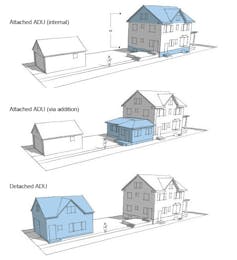How Building More 'Granny Flats' Can Help Alleviate the Housing Crisis

An accessory dwelling unite in Los Angeles. Alisha Jucevic for The Washington Post via Getty Images

Connecting state and local government leaders
COMMENTARY | Recent trends—working from home, aging in place and an expensive housing market—demand housing types that are not readily available in a market dominated by single-family housing.
This article is republished from The Conversation under a Creative Commons license. Read the original article.
To many people, the image of a nuclear family in a stand-alone house with a green lawn and white picket fence still represents a fulfillment of the American dream.
However, this ideal is relatively new within a broader history of housing and development in the U.S. It’s also a goal that has become increasingly unattainable.
As professors of architecture, we explore how cities change over time, and how certain building trends become commonplace through cultural, political, technological and economic shifts.
Over the past century, the U.S. has lost a rich variety of living options because of the homogenization of zoning policies that prioritize single-family housing, as well as developers’ desire to have inexpensive and easily replicated building plans.
These development prescriptions are so pervasive that it is now illegal to build anything other than a single-family house on 75% of residential land in American cities. Single-family zoning restricts the supply of affordable housing, leading to higher costs, displacement and segregation.
Enter the ADU
Diverse patterns of living arrangements across families, communities and plots of land were far more common in the 19th and early 20th centuries.
To accommodate these living situations, a range of housing types emerged: multifamily apartment complexes, housing cooperatives, and duplexes and triplexes.
There were also accessory dwelling units, or ADUs, which are sometimes called “granny flats,” “backyard homes,” “in-law suites” or “backyard cottages.”

These terms all refer to essentially the same thing: an additional unit of housing on a single lot, typically smaller in square footage than the main residence. They include full amenities—a kitchen and a bathroom, along with a separate entry from the primary dwelling. ADUs can either be attached to or detached from an existing house and can either be built from the ground up or be converted from existing spaces, like garages, basements or attics.
You may have heard of minimalist living trends such as van life and tiny homes, but the ADU was the original compact housing.
While ADUs are not new, many Americans are unfamiliar with them. A recent Freddie Mac consumer survey found that 71% of homeowners were unfamiliar with the concept, though 32% expressed interest in having one on their property once they learned about it.
Addressing the ‘Missing Middle’
More diverse living arrangements are both desirable and necessary.
Recent trends—working from home and aging in place, along with a homeownership market that’s pricing out younger adults—all demand housing types that are not readily available in a market dominated by single-family housing.
We believe ADUs—with their social, economic and environmental benefits—should become a more common housing option.
ADUs contribute to sustainability goals primarily because they encourage density. Rather than clearing another lot in a sprawling suburb for a new single-family home, the ADU stealthily adds density to existing neighborhoods, which allows them to tap into the existing infrastructure grid. They can also lead to fewer emissions by encouraging shorter commutes.
Because ADUs are smaller, they also require fewer building materials to construct and less energy to heat; they can be passively cooled and need less electricity. Together, these result in reduced energy costs for the building. Additionally, prefabricated ADUs can be directly purchased, which further reduces construction time, can sidestep regulatory burdens, such as site inspections, and lead to lower costs and waste.
ADUs are also nimble. Twentieth-century forms of development often took a scorched-earth approach to redevelopment by tearing down entire communities—often communities of color—to build entirely new districts through urban renewal programs.
ADUs do not disrupt local communities. Because they don’t require buying up more land, they help add to the density, introducing new people from different walks of life. As neighborhood populations grow, they become more attractive to small businesses. Coffee shops, restaurants and grocery stores are more likely to flourish with more residents in a given area.
ADUs can also fill the gap of much-needed “missing middle” housing. Many new neighborhood developments are marketed as “luxury” and try to take advantage of hot markets by maximizing price points. Affordable housing is typically developed by government housing authorities and nonprofit developers who attempt to meet the pressing housing needs at the lower end of the economic spectrum.
Alternatively, housing that caters to middle-income people is typically nonsubsidized through traditional government funding mechanisms but fills a need that many for-profit developers can’t meet. These are usually smaller homes that attempt to appeal to a variety of price points and lifestyles. Many ADUs could fall into that category.
Finally, at the scale of the household, there are numerous benefits to ADUs.
Going back to its moniker as a “granny flat,” ADUs offer the opportunity for intergenerational living. They are typically a single story, which makes it easier for older family members to age in place. But they also provide space and privacy for younger people who may not be able to afford a larger single-family home.
Some ADUs serve as rental units or short-term rentals. By adding units to the existing rental market, they can stanch soaring rental costs. They can also provide passive income for homeowners who need help paying off their mortgage.
California Leads the Way
To be sure, there is plenty of opposition to ADUs. It often appears from local residents who fear that there won’t be enough parking spaces to accommodate new neighbors and that adding more dwellings to their neighborhoods could decrease property values.
Similarly, bureaucratic hurdles can sometimes discourage homeowners who might otherwise be interested in having their own ADU. Sometimes six or seven separate permits are required, significantly delaying construction.
Los Angeles has had a unique approach to encourage ADUs. The city recently launched its Accessory Dwelling Unit Standard Plan Program, which offers homeowners and developers the option to select from 20 preapproved ADU models for construction. Plans range from a studio structure of less than 400 square feet to a 1,200-square-foot house with three bedrooms.
Since construction or conversion is still relatively expensive and out of reach for many homeowners, the state of California also offers homeowners a $40,000 subsidy to encourage the construction of ADUs to make them more affordable. Meanwhile, CityLAB, a university-affiliated research center at UCLA, designed a guidebook for homeowners looking to build one of these small homes. The guidebook provides a step-by-step process to walk people through information needed to submit an application to the city and find lenders, designers and contractors.
California’s various initiatives have largely been successful. ADU permits increased from 9,000 in 2018 to 12,392 in 2020, according to the UC Berkeley Center for Community Innovation. Seeing the success of ADU policies in cities like Los Angeles and Seattle, Pittsburgh is testing an ADU pilot project in a handful of neighborhoods. Cincinnati is also currently advancing legislation to reverse policies that forbid ADUs.
As the country grapples with alleviating its housing crisis, solutions will require rethinking existing policies and re-imagining what housing development and neighborhood cohesion looks like. ADUs can be one of those solutions.
Jeff Kruth is an assistant professor of architecture at Miami University. Murali Paranandi is a professor of architecture at Miami University

NEXT STORY: Early State Broadband Spending Shows Policy Evolution


